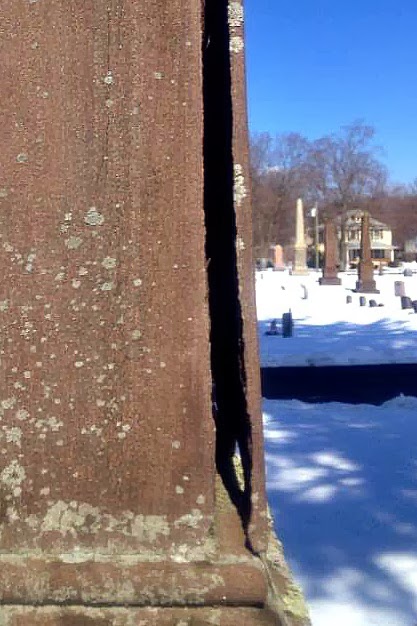 |
Orlando E. Snow, a private in the 16th Connecticut, was described as
"morose" after the death of his brother at the Battle of Antietam.
(Photo: Author's collection) |
Although two 16th Connecticut soldiers were despondent over the deaths of their brothers, comrades resorted to harsh -- even cruel -- means to shake them from their grief.
 |
16th Connecticut soldiers tired of
Orlando Snow's "ill humor" after the death
of his brother, William Relyea (above) of the
16th Connecticut wrote.
(Photo: Connecticut State Library archives) |
Seen frequently "moping around a fire" after his sibling's death, Private Alonzo N. Bosworth of Company D became disgustingly filthy, according to 16th Connecticut Sergeant William Relyea. Francis H. Bosworth, Alonzo's brother, was captured at the Battle of Antietam on Sept. 17, 1862, paroled three weeks later and died in Annapolis on Feb. 20, 1863 of an undetermined cause, perhaps a battle wound. (The 21-year-old soldier had been discharged from the army for disability on Feb. 5, 1863.)
"By and by the boys began to notice his dirty black, grimy looks," Relyea wrote of Alonzo, only a teenager. "He had become so discolored with dirt, grease and smoke as to be almost unrecognizable, and so it was determined among us to wake up his manhood ..."
Instead of consoling the
young soldier from Union, Conn., his comrades pushed Bosworth nearer to a campfire "until he got right in the smoke." Angry that the ploy was unsuccessful in curing Alonzo's apparent depression, one man resorted to an even harsher tactic: pushing Bosworth
directly into the fire.
"...his hands and clothes were burnt some, but it made him mad, so very mad," Relyea wrote, "that he swore terribly. But he kept away from fires and one day soon after he appeared among us with clean face and hands and indeed a new man."
 |
Back of Orlando Snow CDV includes the soldier's name, company and regiment in period writing,
as well as the name of the photographer and Washington studio where the image was made.
The photograph undoubtedly was taken when the 16th Connecticut briefly camped near Washington
before it joined the Army of the Potomac en route to Maryland and the Battle of Antietam. |
Soldiers in the regiment also showed a lack of compassion for Private Orlando E. Snow, whose brother Nelson was killed in John Otto's cornfield at Antietam. (See
my interactive panoramas of Otto's cornfield.) A 23-year-old private, Nelson
was sick several days before Antietam, but his illness didn't keep him from fighting. "(Snow) went into the fight for fear someone would call him a coward," Relyea wrote. "He was brave enough to die."
"Likewise morose" after his brother's death, Orlando "was cured by similar means" used on Bosworth, Relyea wrote.
"After the boys had endured his ill humor for months in pity for his loss, they got tired of it and many were the muttered threats against him if he didn't clean up dirty, lousy, and lazy. One day as he sat in the sun brooding over his sorrow, a little Irishman who was always clean as a whistle came along and stopped before him. Looking at his forlorn face for a moment, he stepped up to Snow and said, 'Begorrah, ye are the dirtiest bit of Snow I've seen in many a day,' and then without a word of warning he struck a ringing blow that made Snow's face look like a piece of toasted bread. Snow sprang to his feet and a lively rough-and-tumble ensued, but our wiry son of Hibernia was to (sic) much for him and the boys laughing parted them. Snow wanted to fight the whole regiment, forgot all his sorrows and became a man once more."
Like their brothers, neither Orlando Snow nor Alonzo Bosworth survived the Civil War. Captured with nearly all their regiment at Plymouth, N.C., on April 20, 1864, they ended up at Andersonville, the most notorious of all Civil War POW camps. Promoted to corporal in January 1863, Alonzo, 20, was the
first soldier in his regiment to perish at Andersonville when he died of diarrhea on June 20, 1864. After the war, he was buried at the camp under Grave No. 2,254. Orlando, 21, also died at Andersonville, probably of disease, on Nov. 17, 1864. His final resting place is unknown.
Sources: Relyea, William, Letter book, 1862-1865, MS 72782, Connecticut Historical Society.
Also by Relyea: "The History of the 16th Connecticut Volunteers, ” MS 72782, CHS. Relyea evidently confused the last name of the Bosworth brothers, recording their last name as "Bostwick." A review of 16th Connecticut rosters found no Bostwick in any company in the regiment, so Relyea must have been in error.
 |
State-issued markers for 16th Connecticut privates Orlando and Nelson Snow in
West Suffield (Conn.) Cemetery. The final resting place of each soldier is unknown. |






















































